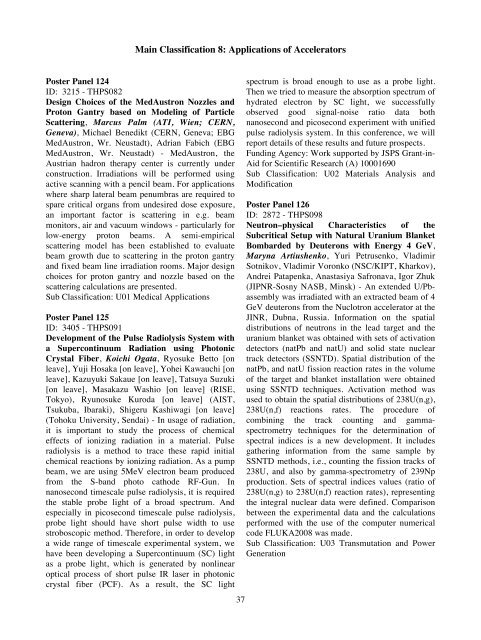Abstracts Brochure - 2nd International Particle Accelerator Conference
Abstracts Brochure - 2nd International Particle Accelerator Conference
Abstracts Brochure - 2nd International Particle Accelerator Conference
Create successful ePaper yourself
Turn your PDF publications into a flip-book with our unique Google optimized e-Paper software.
�<br />
Main Classification 8: Applications of <strong>Accelerator</strong>s<br />
Poster Panel 124<br />
ID: 3215 - THPS082<br />
Design Choices of the MedAustron Nozzles and<br />
Proton Gantry based on Modeling of <strong>Particle</strong><br />
Scattering, Marcus Palm (ATI, Wien; CERN,<br />
Geneva), Michael Benedikt (CERN, Geneva; EBG<br />
MedAustron, Wr. Neustadt), Adrian Fabich (EBG<br />
MedAustron, Wr. Neustadt) - MedAustron, the<br />
Austrian hadron therapy center is currently under<br />
construction. Irradiations will be performed using<br />
active scanning with a pencil beam. For applications<br />
where sharp lateral beam penumbras are required to<br />
spare critical organs from undesired dose exposure,<br />
an important factor is scattering in e.g. beam<br />
monitors, air and vacuum windows - particularly for<br />
low-energy proton beams. A semi-empirical<br />
scattering model has been established to evaluate<br />
beam growth due to scattering in the proton gantry<br />
and fixed beam line irradiation rooms. Major design<br />
choices for proton gantry and nozzle based on the<br />
scattering calculations are presented.<br />
Sub Classification: U01 Medical Applications<br />
Poster Panel 125<br />
ID: 3405 - THPS091<br />
Development of the Pulse Radiolysis System with<br />
a Supercontinuum Radiation using Photonic<br />
Crystal Fiber, Koichi Ogata, Ryosuke Betto [on<br />
leave], Yuji Hosaka [on leave], Yohei Kawauchi [on<br />
leave], Kazuyuki Sakaue [on leave], Tatsuya Suzuki<br />
[on leave], Masakazu Washio [on leave] (RISE,<br />
Tokyo), Ryunosuke Kuroda [on leave] (AIST,<br />
Tsukuba, Ibaraki), Shigeru Kashiwagi [on leave]<br />
(Tohoku University, Sendai) - In usage of radiation,<br />
it is important to study the process of chemical<br />
effects of ionizing radiation in a material. Pulse<br />
radiolysis is a method to trace these rapid initial<br />
chemical reactions by ionizing radiation. As a pump<br />
beam, we are using 5MeV electron beam produced<br />
from the S-band photo cathode RF-Gun. In<br />
nanosecond timescale pulse radiolysis, it is required<br />
the stable probe light of a broad spectrum. And<br />
especially in picosecond timescale pulse radiolysis,<br />
probe light should have short pulse width to use<br />
stroboscopic method. Therefore, in order to develop<br />
a wide range of timescale experimental system, we<br />
have been developing a Supercontinuum (SC) light<br />
as a probe light, which is generated by nonlinear<br />
optical process of short pulse IR laser in photonic<br />
crystal fiber (PCF). As a result, the SC light<br />
37<br />
spectrum is broad enough to use as a probe light.<br />
Then we tried to measure the absorption spectrum of<br />
hydrated electron by SC light, we successfully<br />
observed good signal-noise ratio data both<br />
nanosecond and picosecond experiment with unified<br />
pulse radiolysis system. In this conference, we will<br />
report details of these results and future prospects.<br />
Funding Agency: Work supported by JSPS Grant-in-<br />
Aid for Scientific Research (A) 10001690<br />
Sub Classification: U02 Materials Analysis and<br />
Modification<br />
Poster Panel 126<br />
ID: 2872 - THPS098<br />
Neutron–physical Characteristics of the<br />
Subcritical Setup with Natural Uranium Blanket<br />
Bombarded by Deuterons with Energy 4 GeV,<br />
Maryna Artiushenko, Yuri Petrusenko, Vladimir<br />
Sotnikov, Vladimir Voronko (NSC/KIPT, Kharkov),<br />
Andrei Patapenka, Anastasiya Safronava, Igor Zhuk<br />
(JIPNR-Sosny NASB, Minsk) - An extended U/Pbassembly<br />
was irradiated with an extracted beam of 4<br />
GeV deuterons from the Nuclotron accelerator at the<br />
JINR, Dubna, Russia. Information on the spatial<br />
distributions of neutrons in the lead target and the<br />
uranium blanket was obtained with sets of activation<br />
detectors (natPb and natU) and solid state nuclear<br />
track detectors (SSNTD). Spatial distribution of the<br />
natPb, and natU fission reaction rates in the volume<br />
of the target and blanket installation were obtained<br />
using SSNTD techniques. Activation method was<br />
used to obtain the spatial distributions of 238U(n,g),<br />
238U(n,f) reactions rates. The procedure of<br />
combining the track counting and gammaspectrometry<br />
techniques for the determination of<br />
spectral indices is a new development. It includes<br />
gathering information from the same sample by<br />
SSNTD methods, i.e., counting the fission tracks of<br />
238U, and also by gamma-spectrometry of 239Np<br />
production. Sets of spectral indices values (ratio of<br />
238U(n,g) to 238U(n,f) reaction rates), representing<br />
the integral nuclear data were defined. Comparison<br />
between the experimental data and the calculations<br />
performed with the use of the computer numerical<br />
code FLUKA2008 was made.<br />
Sub Classification: U03 Transmutation and Power<br />
Generation


